マウント無しLED

- LEDs in the UV, Visible, or IR Spectral Ranges
- Broadband Light Sources
- Compatible with Versatile LED Mounts
T-1 3/4 Package
TO-39 Package with Window
TO-18 Package
with Glass Lens
TO-18R Package
Application Idea
TO-39 Package
with Glass Lens
TO-18 LED Shown
in LEDMF Mount
(Post Not Included)
TO-39 Package UV LED with Ball Lens
LEDMT1E
USB-Powered
LED Mount
TO-18 Package
with Glass Cover
TO-46 Package
with Glass Lens
TO-39 Package
UV LED with Aspheric Glass Lens

Please Wait
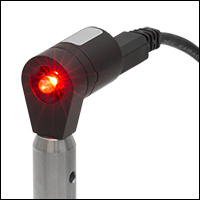
Click to Enlarge
Figure 1.1 USB電源供給LEDマウントLEDMT1Fに取付けられた赤色LED630Eを、レンズマウントLMR05(/M)でポストに取付け
特長
- TO-Can型パッケージ入りマウント無しLED
- 幅広い中心波長のLEDをご用意(Table 1.2をご参照ください)
- 単色LED(250 nm~4.4 µm)
- 多色LED
- 白色LED(430 ~660 nm)
- LEDの出力パワー範囲:6 µW~170 mW
- 種類によって5個入りセットのLEDもご用意
- ポスト取付け用マウント、SMネジ付きマウント、およびLEDソケットを別売りでご用意
- マウント済みLED、ファイバ出力型LED、コリメータ付きLEDなどもご用意(「LEDセレクションガイド」タブをご参照ください)
発光ダイオード(LED)は小型でエネルギー効率の良い光源で、幅広い波長範囲で発光します。当社では、中心波長が250 nm~4.4 µmのマウント無しLEDをご用意しています。これらのマウント無しLEDは、T-1 3/4パッケージのほか、TO-18、TO-46、TO-39、Ø9 mm、TO-18Rなどの様々なTO-Can型パッケージにエポキシで封じられています。UV LEDの中には7.5°以下の狭い角度内に出射光を集光するボールレンズの付いたタイプがありますが、TO-Can型パッケージに納められている他のLEDには、フラットウィンドウ、ガラスカバー、ガラスレンズ、あるいはパラボリックリフレクタの付いたタイプなどがございます。
特定の波長範囲のLEDをご覧になりたい場合には、Table 1.2をご利用ください。各LEDの一般的な情報については下の仕様の表でご覧いただき、比較することができます。仕様の詳細やスペクトル特性については、型番横の赤いアイコン(![]() )をクリックしてSpec Sheetをご覧ください。
)をクリックしてSpec Sheetをご覧ください。
マウント無しLEDの出射光の広がり角は非常に大きいため、実験セットアップ内で使用するには、しばしばレンズを用いて出射光を集光する必要があります。非球面コンデンサーレンズ(380~2100 nm用のコーティング無し、および 350~700 nmまたは650~1050 nm用のARコーティング付きをご用意)は、中心波長405 nm~1600 nmのマウント無しLEDからの光をコリメートするのに適しています。中心波長4400 nmのマウント無しLEDには、出射光の広がり角を抑えるパラボリックリフレクタが付いています。LED光のコリメート方法の詳細は「コリメーション」タブをご覧ください。 「特性評価」タブでは、こちらのページに掲載されている大部分のLEDの出射光特性を評価するための方法と機器を例示しています。 下記以外の製品をお探しの場合には当社までお問い合わせください。
| 波長・色、光パワー、出射光の発散半角などについて、ご希望の仕様のLEDが無い場合は当社にご相談ください。ご希望の製品につきまして、カスタム仕様でのご提供や当社標準品としてのラインナップ化などを検討させていただきます。 |
発光ダイオード(LED)の特性評価方法
ここでは、こちらのページで掲載されているほとんどのLEDの発光特性を評価する部品および装置をご紹介しています。 下の写真に表示されている部品を使用した方法で測定できる仕様は以下の通りです。
- スペクトル分布
- スペクトル幅(FWHM)
- 放射強度分布
- 出射光の発散半角(Half Viewing Angle)
- 前方放射光の光パワー
- 総光パワー
スペクトル分布ならびにスペクトル幅(FWHM)の測定方法
ファイバ入力型の小型分光器CCT10がPCにつながれ、UV*域/可視域(200~1000 nm)の波長範囲のスペクトルが測定されています(近赤外域で発光するLEDはOSA202Cを使用してください)。LEDは定電流モードで動作する半導体レーザードライバLD1255Rによって駆動することができます。 LED光はf = 25.4 mmの両凸レンズLB1761により、分光器につながっているコア径Ø50 µm、SMA905コネクタ付きのマルチモードファイバーパッチケーブルに集光されます。
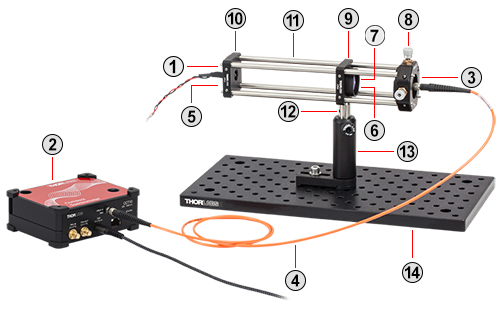
Click to Enlarge
Figure 2.1 使用例:スペクトル分布およびスペクトル幅(FWHM)の測定方法
| # | Imperial Item # | Metric Item # | Product Description | Qty. |
|---|---|---|---|---|
| Visible LEDs (245 nm - 940 nm) | ||||
| 1 | - | LED (245 nm - 940 nm)a | 1 | |
| 2 | CCT10 | Compact Spectrometer, Broadband: 200 - 1000 nm | 1 | |
| 3 | SM1SMA | SMA Fiber Adapter Plate | 1 | |
| 4 | M14L01 | Ø50 µm, SMA905 Fiber Patch Cable | 1 | |
| NIR LEDs (635 nm - 1650 nm)b | ||||
| 1 | - | LED (635 nm - 1650 nm)a | 1 | |
| 2 | OSA202C | Optical Spectrum Analyzer, Wavelength Range: 600 - 1700 nm | 1 | |
| 3 | SM1FC | FC/PC Fiber Adapter Plate | 1 | |
| 4 | M42L01 | Ø50 µm, FC/PC Fiber Patch Cable | 1 | |
| General | ||||
| 5 | S05LEDM | SM05 LED Mount | 1 | |
| 6 | LB1676 | N-BK7 Bi-Convex Lens, Ø1", f = 100.0 mm | 1 | |
| 7 | SM1L03 | SM1 Lens Tube, 0.3" Thread Depth | 1 | |
| 8 | CXY1Ac | XY Translating Lens Mount for Ø1" Optics | 1 | |
| 9 | CP33 | CP33/M | SM1-Threaded 30 mm Cage Plate | 1 |
| 10 | CP32 | CP32/M | SM05-Threaded 30 mm Cage Plate | 1 |
| 11 | ER8-P4 | Cage Assembly Rods, 8" Long, Ø6 mm, 4 Pack | 1 | |
| 12 | TR2 | TR50/M | Ø1/2" x 2" (50 mm) Stainless Steel Optical Post | 1 |
| 13 | UPH3 | UPH75/M | Universal Post Holder, 3" (75 mm) | 1 |
| 14 | MB612 | MB1530/M | Aluminum Breadboard, 6" x 12" (150 mm x 300 mm) | 1 |
| - | HW-KIT2b | HW-KIT2/Mb | 1/4"-20 (M6) Cap Screw and Hardware Kit | 1 |
放射強度分布ならびに発散半角の測定方法
角度に応じた強度パターンを測定するため、LEDは発光強度が最大の軸に対して垂直な軸を中心に回転させます。 ゴニオ回転を得るためにはLEDを電動回転ステージのポストに取り付け、回転軸がLEDの発光面を通るようにしてください。 ステージは、KDC101などのDCサーボモータードライバによって制御し、LEDは半導体レーザードライバLD1255Rで駆動しています。 放射光はLEDから約300 mmの場所に設置したSiフォトディテクタDET36A2、またはゲルマニウム(Ge)フォトディテクタDET30B2で検出します。 LEDの中心が回転ステージCR1/M-Z7の中心上に配置されるようLEDマウントS05LEDMをレンズチューブSM05M10に埋め込んでいます。 迷光や散乱光がディテクタに当たらないよう、LEDよりもやや短いSM1レンズチューブをディテクタに取り付けています。 2つのアイリスSM1D12Cの開口部はLEDからディテクタの光路上に置かれています。 LEDに近いアイリスの開口径は10 mm、ディテクタに近いアイリスの開口径は3 mmです。
LEDが回転すると、光強度に比例するフォトダイオードディテクタの出力が各角度位置ごとにデータ収集カードによって記録されます。 LEDは+90°から-90°まで回転します。このとき0°は、強度が最大な軸がディテクタの軸に対して平行であるときとほぼ一致します。 出射光の発散半角はディテクタの最大出力の50%に相当する角度によって決まります。

Click to Enlarge
Figure 2.2 使用例:放射強度分布および発散半角の測定方法
| # | Imperial Item # | Metric Item # | Product Description | Qty. |
|---|---|---|---|---|
| Visible LEDs (365 nm - 1070 nm) | ||||
| 1 | - | LED (365 nm - 1070 nm)a | 1 | |
| 2 | DET36A2 | Silicon Photodetector Wavelength Range: 350 - 1100 nm | 1 | |
| NIR LEDs (850 nm - 1750 nm) | ||||
| 1 | - | LED (850 nm - 1750 nm)a | 1 | |
| 2 | DET30B2 | Germanium Photodetector Wavelength Range: 800 - 1800 nm | 1 | |
| General | ||||
| 3 | - | Motorized Rotation Stage | 1 | |
| 4 | CR1A | CR1A/M | CR1 Adapter Plate | 1 |
| 5 | KDC101 | K-Cube® DC Servo Motor Controller | 1 | |
| 6 | KPS201b | 15 V Power Supply for One K- or T-Cube™ | 1 | |
| 7 | RC1 | Rail Carrier, 1" x 1" | 1 | |
| 8 | RLA0300 | RLA075/M | Dovetail Optical Rail, 3" (75 mm) | 1 |
| 9 | 2249-C-36 | BNC Coaxial Cable, BNC Male to BNC Male | 1 | |
| 10 | LMR05S | LMR05S/M | Ø1/2" Lens Mount with Internal and External SM05 Threads | 1 |
| 11 | S05LEDM | SM05 LED Mount | 1 | |
| 12 | SM05M10 | SM05 Lens Tube without External Threads, 1" Long | 1 | |
| 13 | SM1D12C | Graduated, Ring-Activated SM1 Iris Diaphragm | 2 | |
| 14 | SM1L30 | SM1 Lens Tube, 3" Thread Depth | 4 | |
| 15 | SM1RC | SM1RC/M | SM1 Series Slim Lens Tube Slip Ring | 1 |
| 16 | TR1 | TR30/M | Ø1/2" x 1" (30 mm) Stainless Steel Optical Post | 1 |
| 17 | TR2 | TR50/M | Ø1/2" x 2" (50 mm) Stainless Steel Optical Post | 2 |
| 18 | UPH2 | UPH50/M | Universal Post Holder, 2" (50 mm) | 2 |
| 19 | MB624 | MB1560/M | Aluminum Breadboard, 6" x 24" (150 mm x 600 mm) | 1 |
| 20 | HW-KIT2 | HW-KIT2/M | 1/4"-20 (M6) Cap Screw and Hardware Kit | 1 |
前方放射光の光パワーの測定方法
LEDの前方放射光の総光パワーは、パワーセンサS120VC(UV/可視域波長用)またはS122C(近赤外域波長用)とパワー&エネルギーメータPM400を使用して測定しています。Figure 2.3をご覧ください。
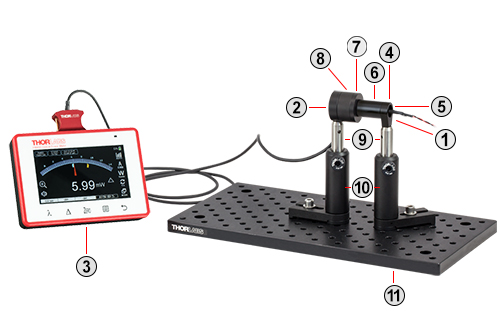
Click to Enlarge
Figure 2.3 使用例:前方放射光の光パワー測定方法
| # | Imperial Item # | Metric Item # | Product Description | Qty. |
|---|---|---|---|---|
| Visible LEDs (245 nm - 1070 nm) | ||||
| 1 | - | LED (245 nm - 1070 nm)a | 1 | |
| 2 | S120VC | Photodiode Power Sensor, Si Wavelength Range: 200 - 1100 nm | 1 | |
| NIR LEDs (780 nm - 1750 nm) | ||||
| 1 | - | LED (780 nm - 1750 nm)a | 1 | |
| 2 | S122C | Photodiode Power Sensor, Ge Wavelength Range: 700 - 1800 nm | 1 | |
| General | ||||
| 3 | PM400 | Touch Screen Power and Energy Meter | 1 | |
| 4 | LMR05S | LMR05S/M | Ø1/2" Lens Mount with Internal and External SM05 Threads | 1 |
| 5 | S05LEDM | SM05 LED Mount | 1 | |
| 6 | SM05M10 | SM05 Lens Tube without External Threads, 1" Long | 1 | |
| 7 | SM1A1 | Adapter with External SM05 Threads and Internal SM1 Threads | 1 | |
| 8 | SM1L05 | SM1 Lens Tube, 0.5" Thread Depth | 1 | |
| 9 | TR2 | TR50/M | Ø1/2" x 2" (50 mm) Stainless Steel Optical Post | 2 |
| 10 | UPH3 | UPH75/M | Universal Post Holder, 3" (75 mm) | 2 |
| 11 | MB612 | MB1530/M | Aluminum Breadboard, 6" x 12" (150 mm x 300 mm) | 1 |
| 12 | HW-KIT2 | HW-KIT2/M | 1/4"-20 (M6) Cap Screw and Hardware Kit | 1 |
総光パワーの測定方法
LEDの総光パワーは積分球を用いて測定します。 放射光はIS200とSM05PD2A、あるいはIS210Cなど、シリコン(UV域または可視域波長用)またはInGaAs(近赤外域用)のフォトダイオードと積分球を使用して検出します。 積分球は当社の半導体レーザーモジュールCPS635Rなどのレーザ光源を用いて校正することが可能です。 フォトダイオードの出力は当社のベンチトップ型フォトダイオード増幅器PDA200Cを使用して増幅ならびに測定が可能です。
| # | Imperial Item # | Metric Item # | Product Description | Qty. |
|---|---|---|---|---|
| Visible LEDs (245 nm - 1070 nm) | ||||
| 1 | - | LED (245 nm - 1070 nm)a | 1 | |
| 2 | IS200 SM05PD2A | Ø2" Integrating Sphere, Si Photodiode, Wavelength: 200 - 1100 nm | 1 | |
| NIR LEDs (850 nm - 1750 nm) | ||||
| 1 | - | LED (850 nm - 1750 nm)a | 1 | |
| 2 | IS210C | Ø2" Integrating Sphere, InGaAs Sensor, Wavelength Range: 800 - 1800 nm | 1 | |
| General | ||||
| 3 | PDA200C | Benchtop Photodiode Amplifier | 1 | |
| 4 | CA2806 | SMA Coaxial Cable, SMA to BNC | 1 | |
| 5 | S05LEDM | SM05 LED Mount | 1 | |
| 6 | TR2 | TR50/M | Ø1/2" x 2" (50 mm), Stainless Steel Optical Post | 1 |
| 7 | UPH3 | UPH75/M | Universal Post Holder, 3" (75 mm) | 1 |
| 8 | MB612 | MB1530/M | Aluminum Breadboard, 6" x 12" (150 mm x 300 mm) | 1 |
| 9 | HW-KIT2 | HW-KIT2/M | 1/4"-20 (M6) Cap Screw and Hardware Kit | 1 |
Video Insight(How-to動画): LEDからの出力光をコリメートする方法
LEDやその他の寸法の大きなインコヒーレント光源からの光をコリメートするのは、意外にも難しい作業になる場合があります。エミッタのサイズ、コリメート用レンズの焦点距離と開口数(NA)など、それらのすべてがコリメートされたビームの特性に影響します。また、レンズが適切な位置にあることを見極めるのも難しい場合があります。この動画では、NAと焦点距離の異なる2つのレンズを使用して、いくつかのコリメート方法をデモンストレーションしています。そのほか、コリメートレンズによって生じるエミッタの像やその他の一般的なビームの特徴についてもご紹介します。
USB LEDの自作
こちらのページに掲載されている多くのLEDは、一時的な使用としてUSBポートから簡単に電源供給することができます。USBポートは、バッテリの充電やデータ転送などさまざまな用途に使用できます。一般的にはPCに付いていますが、それ以外の電子機器や壁面のコンセントにも多く見られるようになってきました。このタブではLEDへの電源供給を目的としたUSBポートの利用方法について順を追って説明しています。初めに、使用するLEDのスペックシートをよくお読みください。順方向電圧の典型値が5 V以上と記載されている場合、USBポートから電源供給することはできません(このことは下記で式2を用いて説明しています)。スペックシートは製品型番横の赤いアイコン(![]() )をクリックしてダウンロードいただけます。
)をクリックしてダウンロードいただけます。
使用例
当社のLED525Lを使用して、USBポートからの電源供給による連続照明装置を作成することができます。この装置には100 Ωの抵抗器を使用してください。この値の算出方法については下記の式3および4をご覧ください。
注意
こちらのチュートリアルには、はんだごてを使用した電子回路の作製が含まれます。手順に従う場合、電子回路の作製に関しては事前に適切な訓練を行ってください。これ以外のLEDへの電源供給方法についてはLED用電流コントローラのページをご覧ください。
手順(クリックすると詳細をご覧いただけます)
部品リスト
部品:
- マウント無しLED
- USB A型オスコネクタ付きケーブル
- 抵抗器(「抵抗器の選択」セクション参照)
- (オプション)A型オスコネクタ付きUSB(USB-C-36)、再利用タイプ
ツール:
- ワイヤーストリッパ
- 絶縁テープ
- はんだごて
- はんだ
- (オプション)熱収縮性チューブ
- (オプション)ヒートガンまたはヘアードライヤ
抵抗器の選択
USB>ポートは最大500 mA(状況によってはそれ以上も可能)の電流を提供できますが、ほとんどのLEDにとってこの電力は大きすぎます。そのため、LEDを直接USBケーブルに接続するとケーブルは数時間で焼損してしまいます。回路内でLEDの前に抵抗器を設置するとUSBポートからの電流を減少させてLEDを駆動させることができます。
用途に適した抵抗器を選択するために、まずはワイヤに電圧を与えるオームの法則から考えていきます。
V=IR (式1),
ここで、Vは電圧、Iは電流、Rは抵抗です。
この場合のVは電源からの出力電圧(Vs)とLEDの順方向電圧(Vf )の差となります(値については各LEDのスペックシートをご覧ください)。VfはLEDを点灯させるために必要な閾値とみなすことができます。この差を式1に置き換えると以下のようになります。
(Vs-Vf )=IR (式2).
Iは当社のLEDの駆動電流と一致します(値については各LEDのスペックシートをご覧ください)。Rを求める式を整理すると以下のようになります。
R=(Vs-Vf )/I (式3).
切り上げた値に最も近い抵抗器を選んでください。
LED525のスペックシートを見ると、最大DC順電流:30 mA、順方向電圧の典型値:3.0 Vaとなっています。最大電流よりも低い値でLEDを駆動し続けるため、20 mAの電流を設定します。USBポートには5 Vの電位があることがわかっているため、式3は次のようになります。
R=(Vs-Vf )/I = (5 V-3 V)/.02 A = 100 Ohm (式4).
100 Ωの抵抗は標準サイズであるため、切り上げる必要はありません。
複数のLEDへの電源供給
複数のLEDが必要な場合は、直列または並列に組み合わせることができます。直列に配置すると、LEDのVfが個数分倍増されるため、より大きなVs が必要となります。LEDにとっては並列に配置した方が有利です。この構成では、電源からより多くの電流が必要ですが、個々のVfはVs によって満たされます。ただし並列の構成では、安全のため各LEDが個別の抵抗器を付けておくことも非常に重要です。1つのLEDが故障した場合、残りのLEDは故障したLEDの電流も負担することになり、システム全体が焼損するおそれがあるからです。
| Posted Comments: | |
user
(posted 2025-05-30 23:14:42.023) I am very interested in the experimental setup described in your documentation titled "Measurement Technique for Radial Intensity Distribution and the Half Viewing Angle."
My goal is to replicate the setup exactly as described by purchasing and assembling the listed components. However, I noticed that the Motorized Rotation Stage used in the system is not specified by model number in the documentation.
Could you kindly recommend a suitable Motorized Rotation Stage model that would be compatible with this setup? ksosnowski
(posted 2025-06-03 12:55:20.0) Hello, and thanks for reaching out to us. The original picture under the Characterization tab above used an older motorized stage, though our similar modern version of this model is part# PRMTZ8. This is also compatible with the same KDC101 controller as in our example. Théo Girerd
(posted 2025-02-19 10:48:42.46) Hello, I have a question: if the data sheet doesn't mention pulsed current, can I still use these LEDs in pulse mode? Thank you very much! jjadvani
(posted 2025-02-20 02:59:19.0) Dear Theo, Thank you for your feedback. Although these LEDs have only been tested in CW mode, it does not mean they cannot be used in pulse mode. You can definitely use it in pulse mode. I will contact you directly to provide further support. Munem Al slem
(posted 2024-12-04 17:36:49.62) Is this IR LED Light not visible? hchow
(posted 2024-12-05 09:07:37.0) Dear Munem Al Slem, thank you for your feedback. No, this IR LED is not visible to the human eye. Although, you can see it if you use a IR viewing cards, like the VRC2 for example. Michael Simmonds
(posted 2024-08-25 09:08:44.793) Hi, need 410 nm for oxygen measurement in blood.
Any chance you have old stock? cdolbashian
(posted 2024-08-26 10:00:46.0) Thank you for reaching out to us with this inquiry. Unfortunately, we do not have any of these left in stock following obsolescence. I have reached out to you directly in an attempt to find a suitable alternative. Germán Cortes
(posted 2024-07-31 11:08:01.56) Hello, excuse me, would it be possible for you to send me the 'LED840L' diode in the LTspice electronic simulator, please? The thing is, I am working on a project where I want to create a current regulator, and for that, I need the LED in the LTspice simulator since I cannot find it. hchow
(posted 2024-08-01 06:55:55.0) Dear Mr. Cortes, thank you for your feedback. We unfortunately do not have any LTspice files for the LED840L. I will personally reach out to you to provide further details. Thank you. Ariel Nachman
(posted 2024-04-17 21:22:14.217) Typical voltage and typical current have some issues:
1. voltage Vs current is not meeting the specification
2. What is the Current Vs forward current graph ? hchow
(posted 2024-04-18 05:48:34.0) Dear Mr. Nachman, thank you for your feedback. I will personally address the issues you are facing with the LED4400P in an email to you. Thank you. James Piao
(posted 2023-05-10 17:27:58.727) Hello,
I ordered this LED and two others. This one is much off the specs (only 0.1 mw, while 1670 nm LED emit 0.6 mw at same driving conditions). This one may be a defect one. hchow
(posted 2023-05-12 09:16:44.0) Dear Mr. Piao, thank you for your feedback. I am sorry to hear that your LEDs aren't performing up to your expectations. I will personally reach to you to see how we can solve this issue for you. Thank you. user
(posted 2023-01-24 03:21:33.367) Hi, I am working with the LED850LW. I am trying to expose the light-emitting chip itself. I have opened up the LED can with a can opener, but it appears that the chip itself is encased in some kind of epoxy. Do you know if there is any way to remove the epoxy? Or alternatively, do you know what material the epoxy is made out of? Do you also sell any LEDs where the chips are not encased in any epoxy? Thank you! dpossin
(posted 2023-01-24 08:00:39.0) Dear customer,
Thank you for your feedback. Unfortunately since we just act as a reseller for the unmounted LEDs, we do not have any influence on the packaging. As an alternative you might have a look at our unmounted chips: https://www.thorlabs.de/thorproduct.cfm?partnumber=M850D3
I am reaching out to you to discuss this in more detail. park yk
(posted 2022-10-06 13:39:44.843) Hello!
Korea Mr. Park
Can I see the maximum output test video? The purchase Proceeded. wskopalik
(posted 2022-10-10 07:58:31.0) Thank you very much for your inquiry!
Unfortunately, we do not have any videos showing this test. But we might have additional information which could be helpful.
I will contact you directly to provide further assistance. Sami Liedes
(posted 2022-05-17 07:46:53.313) Hi! I have a hobby project—to measure/estimate human cone cell responses—in which I'd need to produce different combinations of visible light wavelengths (RGB only doesn't cut it) for observation with human eyes. Your LEDs in the visible light range (and light mixing rods etc) look potentially suitable, but since I'm new to optics, I thought I'd ask what you'd recommend for this use or if you'd even consider them safe for this kind of thing. The electronics side I believe I can handle.
Basically, I would want to control the (approximate) luminosity of the 10-or-so different wavelength LEDs, mix the light and present it to a human eye, either via an eyepiece or on some diffuse white surface, with the goal of finding different (known) spectra that produce the same perception. Obviously I'd be interested in rather small output powers. Also, do you think a light mixing rod is suitable for this? Or do you think one of your diffusers would be good enough? mdiekmann
(posted 2022-05-17 05:00:12.0) Thank you for contacting us! As you selected not to be contacted, could you reach out to our Scandinavian Tech Support team at techsupport.se@thorlabs.com? We will be happy to support you with finding the best solution for this application. Mark Sudberry
(posted 2022-03-12 00:01:15.467) I need this wavelength 1950 in To-18 glass dome lens. soswald
(posted 2022-03-15 06:24:03.0) Dear Mark,
thank you for your feedback. I have reached out to you directly to discuss your application and requirements in more detail. Jakob R
(posted 2022-03-07 03:29:46.407) What is the angular distribution of the following leds? (preferably graphed) LED1800P, LED1900P, LED2050P and LED2350P. They are not specified in the datasheet. And what is the emitter size of those leds? hkarpenko
(posted 2022-03-14 07:55:02.0) Dear Jakob,
thank you very much for your feedback. I will contact you directly to discuss this with you. Parvez Akhtar
(posted 2022-03-07 15:55:22.167) what is the active area of the LED680? mdiekmann
(posted 2022-03-10 06:27:03.0) Thank you for your question. Unfortunately, we cannot publish this information. As you preferred not to be contacted, please reach out to your local tech support for more information. SITI HAJAR AB AZIZ
(posted 2022-02-17 13:52:20.337) Hi, I'm looking for the White LED, and now comparing to buy mounted or unmounted. Mounted LED needs LED driver to function, right? It is opposite to unmounted LED.
Could you provide me details which type I should use for commercial White LED?
I need the LED for illumination and data communication.
Thank you. dpossin
(posted 2022-02-18 04:50:23.0) Dear Hajar,
Thank you for your feedback. In general for every LED you need a suitable driver. We offer drivers only for our mounted LEDs. I am reaching out to you in order to discuss in more detail possible options with you. John Coates
(posted 2022-01-09 15:40:21.833) I am working on a team where we are developing a UV-based spectral sensor. We wish to make an addressable LED array to serve as a scanning UV source. The goal would be to make the array with LED devices that cover 250nm to 400nm with a wavelength separation of 10nm. Can Thorlabs work with us to produce such an array. This will be for a high volume medical application... initially we need to prototype the device... but eventually we would integrate this into a handheld measurement system, to be sold in quantities of 1000 to 100,000.
Please advise whether Thorlabs is able to provide such a device. Our company has experience in making commercial instrumentation... company name is Lightsense...based in Tucson, AZ.
Thank you... John Coates cdolbashian
(posted 2022-01-10 12:02:27.0) Thank you for reaching out to us at Thorlabs with this OEM request. I have reached out to you directly, and put you in contact with our OEM/Solutions team, who will discuss the specifics for your custom LED solution. 娇娇 范
(posted 2021-08-19 09:30:22.8) 咨询产品LED430L的辐射稳定性情况、寿命情况,希望获得相关数据,比如曲线图。 Rod Wesson
(posted 2021-08-02 17:10:18.22) Hi
I think the spec sheet is wrong for this device as it says on the drawing bottom view but the pins and tab appear to show top view. Also could you please confirm if there is any preference on connecting the case to either the cathode, anode or just the shield of the controller as the case on the LED340W appears to be connected to the anode according to its drawing. Thanks dpossin
(posted 2021-08-16 09:28:11.0) Dear Rod,
Thank you for your feedback. We correct the specsheet. I am reaching out to you in order to provide further information. sandeep kumar
(posted 2021-05-17 17:34:41.89) We have purchased these led a year ago. I want to know, what material is used to make the LED legs (cathode and anode). It will be helpful if you can provide the details. MKiess
(posted 2021-05-21 04:30:11.0) Dear Sandeep, thank you very much for your inquiry. The material of the LED591E legs is SPCC steel. Sagar S
(posted 2021-04-30 15:08:34.597) Hi, Any reference application circuit to drive the LED1900P? The Spec sheet doesn't have the voltages information, if you could provide them - would be helpful. Thanks! dpossin
(posted 2021-05-03 05:18:04.0) Dear Sagar,
Thank you for your feedback. The forward voltage in the QCW mode is rated to 0.5-2.5V at 200mA driving current. A suitable LED driver would be the DC2200. I am reaching out to you to further discuss this. Ulrich Leischner
(posted 2020-12-09 10:33:50.493) Hello
We would need this device with the colors green, red, and IR (preferably with light >1050nm, this would be an 1200nm-IR-LED). Would this be possible to generate such a product?
Regards
Ulrich Leischner wskopalik
(posted 2020-12-10 09:01:32.0) Thank you very much for your inquiry!
Multi-Color LEDs are unfortunately mainly designed for illumination applications and are therefore mainly available with LEDs emitting visible light.
I will however check if such a custom is possible and will contact you directly. Andrew Davies
(posted 2020-08-10 17:57:44.96) What is the emitter size for LED528EHP, LED525L, LED528EHP, LED555L, and LED570L? MKiess
(posted 2020-08-11 09:14:10.0) Dear Andrew, thank you very much for your inquiry. I have contacted you directly to discuss the specifications in detail. Yanting Lu
(posted 2020-07-07 01:38:13.14) Ask for the curve of Forward Current vs. Forward Voltage MKiess
(posted 2020-07-08 06:42:32.0) This is an response from Michael of Thorlabs. Thank you very much for your inquiry. The general specifications can be found on our website at the respective product. For further information I have contacted you directly. jason Hu
(posted 2019-12-11 14:17:16.027) Why does 1450nm infrared LED, after lighting for a period of time (about 2 hours), reduce the luminous intensity by 30%? Is it related to the way of heat dissipation? If so, how to cool it?
Which is the main cooling surface of this led? dpossin
(posted 2019-12-12 10:18:20.0) Dear customer,
Thank you for your feedback. As the LED1450L has a power consumption of 50mW but emits an optical power of 5mW, the heat dissipation is 45mW. Therefore it is needed to introduce thermal management. I am reaching out to you in order to provide further information. Ludovic Angot
(posted 2019-08-05 03:51:22.137) Please review the spec sheet of your LEDRGBE RGB led, as of the date of posting it is incorrect: a 2 pins LED is shown in section 2.5 and with the wrong anode and cathode configuration. Also do you confirm that the max DC forward current (stated at 50mA) is valid for each individual RGB channels? MKiess
(posted 2019-08-07 08:55:09.0) This is a response from Michael at Thorlabs. Thank you very much for the feedback. You're absolutely right that this representation is incorrect. We will correct it immediately. The DC forward current of 50mA is valid for each individual RGB channels. Thank you very much for this information. Sanket Shah
(posted 2019-07-31 11:04:30.18) The spec sheet does not specify the electrical requirements of the LED4300P well enough, and the mechanical drawing is also unclear with the actual numbers not readable. I need to know if it can be operated at duty cycles in between the mentioned operating modes qCW & pulsed. Also missing is the maximum voltages that are acceptable. dpossin
(posted 2019-08-29 06:58:13.0) Hello Sanket,
Thank you for your feedback! We are currently updating the manual in question to achive a better usability for our customers. We recommend using Quasi Continues Wave mode with a duty cycle 50% or 25% to obtain maximum average optical power and short Pulse modes to obtain maximum peak power. Hard CW mode is not recommended. The maximum voltage for qCW mode @ 2A is 0.8V. I hope that helps. user
(posted 2019-04-02 12:29:08.32) Could you please help to answer the following questions regarding LED470L.
What is the raw LED size?
What is the focal length of its ball lens?
Is it possible to get Zemax file of LED470L?
Thanks,
Paul Huang
Principal Optical Research Engineer
Panduit Corp.
6200 W 175th St
Tinley Park, IL 60477
Tel: (708) 532-1800 x 81137
Email: yuh@panduit.com swick
(posted 2019-04-08 04:19:21.0) This is a response from Sebastian at Thorlabs. Thank you for the inquiry.
The chip size for LED470L is 1.3 x 1.3 mm.
Unfortunately, we have no data for the ball lens and there is no Zemax file available for this LED.
I contacted you directly to provide assistance. kkmion
(posted 2018-08-10 10:06:17.557) Can the Quasi-CW LED be driven by LEDD1B? YLohia
(posted 2018-08-13 12:14:47.0) Thank you for contacting Thorlabs. Yes, the LED2350P can be driven by the LEDD1B. You would, however, have to perform the wiring yourself. Please note that the rise/fall time of LEDD1B is ~350 us in the Trigger Mode. lylaana
(posted 2018-01-25 09:32:05.387) 1. Optical Output Power is the total power before the lens or the power after the lens?
2. Since it’s a tiny lens, the light collimating efficiency can't be very good,how much would that collimating efficiency be about?
3. Do you have the distribution figure before collimating for LED450L,the LED chip? So I can decide how the distribution is changing,or is it worth to sacrifice the LED power?
4. What's the best you can do to achive a much better collimated LED with such conpact package? Or should I say is it possible?
THANKS. nbayconich
(posted 2018-02-16 09:42:44.0) Thank you for contacting Thorlabs. The optical power is specified after the lens or window in these types of LED packages. We do not specify a collimating efficiency for use with an additional lens, the ability to collimate an LED will depend on the divergence and chip size of the LED however it is not possible to perfectly collimate an LED source in the same way a laser diode can be.
Please see our spec sheet located below for more information about the intensity distribution vs. angle below.
https://www.thorlabschina.cn/_sd.cfm?fileName=QTN015134-S01.pdf&partNumber=LED450L
If you use an AR coated lens to collimate this LED your loss in power should be reduced to a minimum. I recommend using one of the condenser aspheric lenses to collimate these LED's, and if the intensity distribution is not suitable for your application a diffused surface aspheric lens may be a better option.
https://www.thorlabschina.cn/newgrouppage9.cfm?objectgroup_ID=5812 user
(posted 2016-12-14 10:52:12.673) Hello,
do you have a plot of the wavelenght shift for 1050E LED as function of temperature? I would like to use it down to 77K. Thanks tfrisch
(posted 2016-12-15 12:49:59.0) Hello, thank you for contacting Thorlabs. Unfortunately, we do not have any test data at 77K. I have doubts about whether the device may work at all at such low temperatures. thomas.nappez
(posted 2015-11-03 18:17:18.543) Hello,
I am currently using LEDs in pulsed operation with a driver circuit closed to the figure 1 of this link: http://elib.dlr.de/64324/1/mst075402_ledpiv_willert_2010.pdf
It works very well with the LED528EHP, with large increase of average optical output power. However when using the LED1450E (with adapted Vs), the output power is not increased (compared to continuous operation). Do you recommend a specific schematic for the pulse operation of InGaAs LEDs?
Best regards,
Thomas besembeson
(posted 2015-11-05 11:08:31.0) Response from Bweh at Thorlabs USA: I will look into this and follow-up with you via email. m.examinateur
(posted 2015-10-27 23:54:16.35) je vais utiliser le en mon projet
je suis en Algérie besembeson
(posted 2015-10-28 05:08:16.0) Response from Bweh at Thorlabs USA: I will contact you for any questions you may have regarding these LEDs. lcolchero
(posted 2015-01-14 21:46:05.28) Dear Sir:
In order to use this LED635L product I need even a more speficic datasheet, including pinout, SOA , pulsed operation, Temperature dissipation coefficient (ºC /W ), whether the 3 pin means optical power output fotodiode feedback posible as well as both katode - anode pins , Max switching frequncy, etc. Without this, it is useless to start designing anything , even the PCB I have in mind to design to this...
Could you provide a more complete datasheet please?
Many thanks in advance
Luis jlow
(posted 2015-01-20 02:37:30.0) Response from Jeremy at Thorlabs: We will look into including more information on the LED. In the meantime, we will contact you directly to provide more information on the LED. kevin.murphy
(posted 2014-02-17 18:13:15.003) Hi, is there any mount, that is compatible with the S1LEDM, available for a 3mm T1 packaged LED? Thanks cdaly
(posted 2014-02-25 04:02:07.0) Response from Chris at Thorlabs: Thank you for your feedback. At the moment we do not have an adapter which will allow a T1 package LED to be mounted in the S1LEDM or any of our other LED mounts. I apologize for any inconvenience this may cause. We will look into adding such an adapter in the future. mc.guacheta177
(posted 2013-10-28 08:11:58.907) Hi, I am a researcher at the Los Andes University and I am working with the infrared spectrum. I would like to know if there is any adaptation or conditioning circuit so I can use element LED4300P. Thank you very much. jlow
(posted 2013-10-29 14:46:00.0) Response from Jeremy at Thorlabs: We do not have an operating circuit available for the LED. However, you can use a constant current source (we recommend that this be driven with a quasi-CW or pulsed signal) to drive this LED. I will contact you to provide more information on this. a.andreski
(posted 2013-10-16 21:37:24.707) Hi,
Do you know what is the emitter area of the 370E (I suppose all the unmounted LEDs here are single-emitter sources)?
Aleksandar pbui
(posted 2013-10-31 04:16:28.0) Response from Phong at Thorlabs: The emitter area of the single-emitter LED370E is 350um x 350um. kevinserg
(posted 2013-09-06 12:05:54.977) Good afternoon.
I have some questions about LED2350P.
1)There is LED2350P Package TO-18(with Reflector) drawing on 3th page LED2350P datasheet. There is "window" on top LED2350P Package on the drawing. Word "window" is red color.
But we buy 2pieces of LED2350P without any window. Why there isn`t window on top our LED2350P? Now we place an order on 1 piece of LED2350P in firm Eurolase (in Russia). Can you make LED2350P with protective window for us? Is this window option?
2) You should correct and write warning in LED2350P datasheet: "LED2350P anod is connected to the LED2350P Package!"
3) We use LED2350P in such pulse mode regime: twidth=5uS, tperiod=0.5Sec, Ipulse=1A. LED2350P is mounted on heatsink. Can I use these pulse mode parameters for LED2350P? I can`t make twidth=1uS, as recommended in LED2350P datasheet.
Best regards, Sergey. jlow
(posted 2013-09-11 15:45:00.0) Response from Jeremy at Thorlabs: We are working on correcting the spec sheet and description issue. For #3, since you are increasing the duty cycle a bit, I would suggest decreasing the current slightly, to 0.95A. kevinserg
(posted 2013-01-22 10:00:44.447) Hello, please, answer my questions about LED370E and LED2350P. Sorry for my English.
1) Can LED370E be used in pulsed regime? There is no pulsed regime description in LED370E data sheet. What is Peak Pulsed Forward Current for LED370E? Are there data for forward voltage vs current and output power vs current for LED370E?
2) Are there data for forward voltage vs current and output power vs current for LED2350P?
3) What is the minimum distance between LED2350P and print circuit board? Can I mount LED2350P close to PCB?
4) Please, recommend IC (integrated circuit) for pulsed regime of LED2350P with parameters: pulse=1uS, period=500uS, pulse current=1A.
5) There is mismatch (mistake?) for pulsed regime figure of LED2350P:
I peak pulsed=2A (in file "LED2350P-SpecSheet.pdf")
I peak pulsed=1A (in file "1353.pdf") Where is true? tcohen
(posted 2012-09-05 13:43:00.0) Response from Tim at Thorlabs: The LED3100P has gone obsolete and has no direct replacement. If you are looking for the supporting documentation for this LED, this can be found by searching this product number. If you have any questions on this product, please contact us at techsupport@thorlabs.com. user
(posted 2012-08-31 02:39:00.0) Why can't I find the 3100 nm led? tcohen
(posted 2012-06-22 09:16:00.0) Response from Tim at Thorlabs: 5V will damage this diode. Please check the spec sheet for the forward voltage of this LED (~1.15V at 50mA). To use 5V you would need to include a resistor based on the desired current and forward voltage of the LED. With a forward voltage of 1.15V and 5V DC supply, you can see the series resistor needed to induce 50mA of current is just (5V-1.15V)/50mA. We recommend using a constant current source for these products. The bare LED has a half viewing angle of 15 degrees and the power is ~7.5mW. This is a divergent source and not very high power. However, care must always be taken when introducing optical elements into a beam path and any concerns of safety should be addressed with your laser safety officer. matt968
(posted 2012-06-20 12:01:40.0) LED1070E: Do I just apply 5V to the positive leg to get this thing to light up or are there other electrical components needed? Is the emission from this LED at 1070nm eyesafe? tcohen
(posted 2012-04-19 09:28:00.0) Response from Tim at Thorlabs: We do not have expected lifetime data for this LED. As always, you can prolong the life of your LED and reduce degradation by reducing the drive current and junction temperature. paul.lauria
(posted 2012-04-17 20:15:39.0) What is the expected lifetime of the LED470L? sharrell
(posted 2012-02-21 11:13:00.0) A response from Sean at Thorlabs:
Thank you for your feedback on the LED780E spec sheet. We will update the spec sheet with the correct plot as soon as the data is available. In the meantime, if you needed a normalized intensity curve for the LED780E, we have one on the catalog page located at http://www.thorlabs.com/catalogpages/V21/1345.PDF. Thank you for pointing out this error. lindsey.couvreur
(posted 2012-02-17 10:01:04.0) There is a mistake in LED780E data sheet: Typical LED591E Spectral Distribution appears instead. sharrell
(posted 2011-12-19 15:33:00.0) A response from Sean at Thorlabs: Thank you for your feedback. I am sorry that you had difficulty using our feedback form, and I have forwarded your comment to our webteam.
Regarding your feedback on our spec sheet plots, we will try to better integrate this information into our website, most likely using the "more info icon" you suggested. user
(posted 2011-12-19 14:51:07.0) Second try... your system said no key was found, would be nice to preserve the text if someone has an entry error...
Comment was that it is hard to get at the spectral plot provided on the Spec Sheets, please consider using the same method that is used for the Laser Diodes, where there is a "i" icon that triggers a pop up window with more data. It would work for me if that pop up gave a representative spectral plot. bdada
(posted 2011-12-13 19:25:00.0) Response from Buki at Thorlabs:
We are working on compiling the current vs output data for our LEDs and adding it to our website. Please email TechSupport@thorlabs.com so we can send you the data when we get it. user
(posted 2011-12-12 18:01:38.0) Is there data for current vs. output power for these LED's? In particular I'm interested in the LEDWE-15. Thank you. jjurado
(posted 2011-03-10 15:47:00.0) Response from Javier at Thorlabs to last poster: Thank you for submitting your inquiry. The UV-TOP LEDs have a rise time in the range 1-2 ns, which translates into a modulation frequency of 350 MHz to 175 MHz. Our LEDs for the visible and infrared range exhibit similar performance. Please contact Tech Support at techsupport@thorlabs.com for questions about a particular LED. user
(posted 2011-03-09 17:18:48.0) How fast can I modulate this LEDs? thanks Thorlabs
(posted 2011-01-19 10:18:43.0) Response from Javier at Thorlabs to ruelas: Thank you very much for submitting your feedback. We have reviewed the specifications and you are correct, the half-viewing angle spec for the LEDWE-50 is, in fact, 25 degrees. We will correct this information on the webpage accordingly. ruelas
(posted 2011-01-17 21:24:19.0) We have purchased several of the LEDWE-50 LEDs in the past and we have just noticed the viewing angle specification is inconsistent inconsistent; the webpage says the half-viewing angle is 50degrees, when it is actually 25 degrees, as specified in the catalog. Thorlabs
(posted 2010-08-20 10:37:02.0) Response from Javier at Thorlabs to smuehlen: Thank you for your feedback. The spectral distribution graphs are available on the spec sheets of our LEDs. I will send you a copy of the spec sheet of the LEDRGBE, which is also available here: http://www.thorlabs.com/Thorcat/16400/16400-S01.pdf smuehlen
(posted 2010-08-19 11:09:26.0) Are there any documents about the spectral distribution of the LEDRGBE as a function of the three applied voltages? This would be very helpful! Thorlabs
(posted 2010-08-06 18:10:50.0) Response from Javier at Thorlabs to sgourley: Thank you for your feedback. The typical full width at half maximum (FWHM) value for this diode is 100 nm. sgourley
(posted 2010-08-06 16:01:16.0) What is the bandwidth of the LED1300E? We have a replacement 1300nm design that is in the 50uW power level. We actually will need to mount in a TO-46 hole but appears it may be possible with this LED.
Thanks,
Sam G Thorlabs
(posted 2010-07-29 09:25:59.0) Response from Javier at Thorlabs to Vincent: Thank you for your feedback. We are currently looking into this for you. I will contact you directly once we have the details. vincent.thominet
(posted 2010-07-27 07:32:40.0) Please what are
the emitting area plane relatively to the housing
and the window glass and thickness?
Best regards
Vincent leichner
(posted 2009-11-05 12:41:39.0) A response from Lou at Thorlabs to abytas:
The LED341 is mid UV light emitting diode. It will emit light at approx 340nm (+/- 10nm) The window of the LED is a flat window and is not a lens. For your application the LED might proof best operation to involve a laser diode driver. You will have precise control over the light being emitted (power).
Im not sure how you want to use the emitting light. The light will diverge at about 15 degrees from the emitter. Typically such light would need to captured by collimation and focusing. But the type of optics required would depend on you use. abytas
(posted 2009-11-02 10:33:41.0) Dears,
I`m asking for power deep UV LED`s for our cardiac tissue luminescense explorations.
It might be Hemispherical Lens LED (T0-39) LED341
Sincere,
Dr. Algimantas Bytautas
Scientist
Kaunas Medical University BMTI
Eiveniu g. 4
LT-50161, Kaunas
LITHUANIA
Ph.: +37037302966
Mob: +37060608444
Fax: +37037777651 (by request) |
こちらのページでは当社が販売するすべてのLEDをご覧いただけます。More [+]をクリックすると、下の各LED製品の波長をご覧いただけます。
| Light Emitting Diode (LED) Selection Guide | ||||||
|---|---|---|---|---|---|---|
| Click Photo to Enlarge (Representative; Not to Scale) |  |  |  |  |  |  |
| Type | Unmounted LEDs | Pigtailed LEDs | LEDs in SMT Packages | LED Arrays | LED Ring Light | Cage-Compatible Diffuse Backlight LED |
| Light Emitting Diode (LED) Selection Guide | ||||||
|---|---|---|---|---|---|---|
| Click Photo to Enlarge (Representative; Not to Scale) |  |  |  |  |  |  |
| Type | PCB- Mounted LEDs | Heatsink- Mounted LEDs | Collimated LEDs for Microscopyb | Fiber- Coupled LEDsc | High-Power LEDs for Microscopy | Multi-Wavelength LED Source Optionsd |

| Item # | Wavelengtha,b | Optical Powera,c | Spectral FWHMa | Viewing Half Anglea | Max DC Forward Currentd | Package |
|---|---|---|---|---|---|---|
| LED255W | 255 nm | 0.4 mW | 11 nm | 60° | 30 mA | TO-39 |
| LED275W | 275 nm | 1.6 mW | 11 nm | 60° | 30 mA | Ø9 mm |
| LED285J | 285 nme | 1.3 mWd | 11 nmc,d | 6°c,d | 30 mAd | TO-39 |
| LED290W | 290 nm | 1.6 mW | 11 nm | 60° | 30 mA | Ø9 mm |
| LED295W | 295 nm | 1.2 mW | 11 nm | 60° | 30 mA | TO-39 |
| LED310W | 310 nmf | 1.5 mW | 15 nm | 57° | 40 mA | TO-39 |
| LED325W2 | 325 nmf | 1.7 mW | 11 nm | 57° | 40 mA | TO-39 |
| LED340W | 340 nmf | 1.7 mW | 9 nm | 57° | 40 mA | TO-39 |
| LED341W | 340 nm | 0.33 mW | 15 nm | 60° | 20 mA | TO-39 |
| LED375L | 375 nmf | 1 mW | 10 nm | 20° | 30 mA | TO-18 |
| LED370E | 375 nm | 2.5 mW | 10 nm | 19° | 30 mA | T-1 3/4 |
| LED385L | 385 nmf | 5 mW | 12 nm | 16° | 30 mA | TO-18 |
| LED395L | 395 nmf | 6 mW | 15 nm | 16° | 30 mA | TO-18 |
| LED405L | 405 nmf | 6 mW | 20 nm | 17° | 30 mA | TO-18 |
| LED405E | 405 nm | 10 mW | 15 nm | 5° | 30 mA | T-1 3/4 |

| Item # | Wavelengtha,b | Optical Powera | Spectral FWHMa | Viewing Half Anglea | Max DC Forward Currentc | Package |
|---|---|---|---|---|---|---|
| LED430L | 430 nm | 8 mW (at 20 mA) | 20 nm | 22° | 50 mA | TO-18 |
| LED450L | 450 nm | 7 mW (at 20 mA) | 20 nm | 20° | 50 mA | TO-18 |
| LED450LW | 450 nm | 90 mW (at 100 mA) | 16 nm | 50° | 150 mA | TO-39 |
| LED465E | 465 nmd | 20.0 mW (at 20 mA) | 25 nm | 8° | 50 mA | T-1 3/4 |
| LED470L | 470 nm | 170 mW (at 350 mA) | 22 nm | 7º | 350 mA | TO-39 |
| LED490L | 490 nm | 3 mW (at 20 mA) | 20 nm | 20° | 50 mA | TO-18 |
| LED505L | 505 nm | 4 mW (at 50 mA) | 30 nm | 20° | 30 mA | TO-18 |
| LED525E | 525 nmd | 2.6 mW (at 20 mA) | 32 nm | 7.5° | 30 mA | T-1 3/4 |
| LED525L | 525 nm | 4 mW (at 50 mA) | 25 nm | 20° | 30 mA | TO-18 |
| LED528EHP | 525 nmd | 7.0 mW (at 20 mA) | 35 nm | 9° | 50 mA | T-1 3/4 |
| LED545L | 545 nm | 2.4 mW (at 20 mA) 8.7 mW (Pulsed, at 100 mA) | 39 nm | 12° | 50 mA | TO-18 |
| LED560L | 562 nmc | 0.15 mW (at 20 mA)c 0.6 mW (Max, at 50 mA)c | 11 nmc | 6°c | 50 mA | TO-18 |
| LED570L | 570 nm | 0.3 mW (at 20 mA) | 15 nm | 20° | 50 mA | TO-18 |
| LED590L | 590 nm | 2 mW (at 50 mA) | 15 nm | 20° | 30 mA | TO-18 |
| LED591E | 590 nmd | 2 mW (at 20 mA) | 20 nm | 10° | 50 mA | T-1 3/4 |
| LED595LW | 595 nm | 45 mW (at 100 mA) | 75 nm | 50° | 150 mA | TO-39 |
| LED600L | 600 nm | 3 mW (at 50 mA) | 12 nm | 15° | 75 mA | TO-18 |
| LED610L | 610 nm | 8 mW (at 50 mA) | 12 nm | 25° | 75 mA | TO-18 |
| LED625E | 625 nme | 9 mW (at 20 mA)c | 20 nmc,f | 10°c,f | 50 mA | T-1 3/4 |
| LED625L | 625 nm | 12 mW (at 50 mA) | 14 nm | 24° | 75 mA | TO-18 |
| LED630L | 630 nm | 16 mW (at 50 mA) | 14 nm | 22° | 75 mA | TO-18 |
| LED635L | 635 nmd | 170 mW (at 350 mA) | 15 nm | 7° | 500 mA | TO-39 |
| LED630E | 639 nmd | 7.2 mW (at 20 mA) | 17 nm | 7.5° | 50 mA | T-1 3/4 |
| LED645L | 645 nm | 16 mW (at 50 mA) | 16 nm | 20° | 75 mA | TO-18 |
| LED660L | 660 nm | 13 mW (at 50 mA) | 14 nm | 18° | 75 mA | TO-18 |
| LED670L | 670 nm | 12 mW (at 50 mA) | 22 nm | 22° | 75 mA | TO-18 |
| LED680L | 680 nm | 8 mW (at 50 mA) | 16 nm | 20° | 75 mA | TO-18 |

| Item # | Wavelengtha,b | Optical Powera | Spectral FWHMa | Viewing Half Anglea | Max DC Forward Currentc | Package |
|---|---|---|---|---|---|---|
| LED750L | 750 nm | 18 mW (at 50 mA) | 23 nm | 11° | 75 mA | TO-18 |
| LED760L | 760 nm | 24 mW (at 50 mA) | 24 nm | 12° | 75 mA | TO-18 |
| LED770L | 770 nm | 22 mW (at 50 mA) | 28 nm | 12° | 75 mA | TO-18 |
| LED780E | 780 nmd | 18 mW (at 50 mA) | 30 nm | 10° | 100 mA | T-1 3/4 |
| LED780L | 780 nm | 22 mW (at 50 mA) | 25 nm | 12° | 75 mA | TO-18 |
| LED800L | 800 nm | 20 mW (at 50 mA) | 30 nm | 12° | 75 mA | TO-18 |
| LED810L | 810 nm | 22 mW (at 50 mA) | 30 nm | 12° | 75 mA | TO-18 |
| LED830L | 830 nm | 22 mW (at 50 mA) | 32 nm | 12° | 75 mA | TO-18 |
| LED840L | 840 nm | 22 mW (at 50 mA) | 35 nm | 12° | 75 mA | TO-18 |
| LED850LN | 850 nm | 100 mW (at 500 mA) | 55 nm | 3.5° | 500 mA | TO-39 |
| LED850LW | 850 nm | 140 mW (at 500 mA) | 55 nm | 55° | 500 mA | TO-39 |
| LED851L | 850 nmd | 13 mW (at 20 mA) | 40 nm | 10° | 100 mA | TO-18 |
| LED870E | 870 nmd | 22 mW | 40 nm | 10° | 100 mA | T-1 3/4 |
| LED870L | 870 nm | 24 mW (at 50 mA) | 42 nm | 13° | 75 mA | TO-18 |
| LED890L | 890 nm | 12 mW (at 50 mA) | 44 nm | 14° | 75 mA | TO-18 |
| LED910L | 910 nm | 10 mW (at 50 mA) | 44 nm | 12° | 75 mA | TO-18 |
| LED910E | 910 nmd | 12 mW (at 50 mA) | 35 nm | 7° | 100 mA | Ø5.5 mm |
| LED930L | 930 nm | 15 mW (at 50 mA) | 60 nm | 14° | 75 mA | TO-18 |
| LED940E | 940 nmd | 18 mW | 50 nm | 10° | 100 mA | T-1 3/4 |
| LED970L | 970 nm | 5 mW (at 50 mA) | 46 nm | 14° | 75 mA | TO-18 |
| LED1050E | 1050 nmd | 2.5 mW | 55 nm | 15° | 100 mA | T-1 3/4 |
| LED1050L | 1050 nm | 4 mW (at 50 mA) | 50 nm | 15° | 100 mA | TO-18 |
| LED1050L2 | 1050 nmc | 8 mW (at 50 mA)c | 42 nmc | 9°c | 100 mAc | TO-46 |
| LED1070L | 1070 nm | 4 mW (at 50 mA) | 55 nm | 15° | 100 mA | TO-18 |
| LED1070E | 1070 nmd | 7.5 mW (at 50 mA) | 80 nm | 15° | 100 mA | T-1 3/4 |
| LED1085L | 1085 nm | 5 mW (at 50 mA) | 50 nm | 15° | 100 mA | TO-18 |
| LED1200E | 1200 nmd | 2.5 mW (at 20 mA) | 100 nm | 15° | 100 mA | T-1 3/4 |
| LED1200L | 1200 nm | 5 mW (at 50 mA) | 70 nm | 15° | 100 mA | TO-18 |
| LED1300E | 1300 nmd | 2 mW (at 20 mA) | 100 nm | 15° | 100 mA | T-1 3/4 |
| LED1300L | 1300 nm | 3.5 mW (at 50 mA) | 85 nm | 20° | 100 mA | TO-18 |
| LED1450E | 1450 nmd | 2 mW (at 20 mA) | 100 nm | 15° | 100 mA | T-1 3/4 |
| LED1450L | 1450 nm | 5 mW (at 50 mA) | 105 nm | 14° | 100 mA | TO-18 |
| LED1550E | 1550 nmd | 2 mW (at 20 mA) | 100 nm | 15° | 100 mA | T-1 3/4 |
| LED1550L | 1550 nm | 4 mW (at 50 mA) | 120 nm | 15° | 100 mA | TO-18 |
| LED1600L | 1600 nm | 2 mW (at 50 mA) | 130 nm | 15° | 100 mA | TO-18 |

| Item # | Center Wavelengtha,b | Optical Powera,b | Spectral FWHMa,b | Viewing Half Anglea | Max Quasi-CW (qCW) Forward Currenta | Package |
|---|---|---|---|---|---|---|
| LED4400P | 4400 nmc | 12 µW qCW at 200 mA | 800 nm (Min) 1200 nm (Max) | 5°d | 250 mA | TO-18R |

| Item # | Center Wavelengtha | Optical Powera | Spectral FWHMa | Viewing Half Anglea | Max DC Forward Currentb | Package |
|---|---|---|---|---|---|---|
| LEDGR | 625 nm and 572 nm | 0.19 mW and 0.09 mW (at 20 mA) | 40 nm and 30 nm | 15° | 30 mA | T-1 3/4c |
| LEDRY | 617 nm and 588 nm | 0.19 mW and 0.09 mW (at 20 mA) | 45 nm and 35 nm | 30° | 30 mA | T-1 3/4c |
| LEDRGBE (R, G, and B) | 627.5 nm, 525 nm, and 467.5 nm | 5.8 mW, 3.1 mW, and 6.2 mW | 20 nm, 36 nm, and 15 nm | 25° | 50 mA | T-1 3/4c |

| Item # | Wavelength Rangea | Optical Powera,b | Spectral FWHMa | Viewing Half Anglea | Max DC Forward Currentc | Package |
|---|---|---|---|---|---|---|
| LEDWE-15d | 430 - 660 nm | 13.0 mW | N/A | 7.5° | 30 mA | T-1 3/4 |
| LEDW7E | 430 - 660 nm | 15.0 mW | N/A | 7.5° | 30 mA | T-1 3/4 |
| LEDW25E | 430 - 660 nm | 15.0 mW | N/A | 25° | 30 mA | T-1 3/4 |

| Item # | LEDMT1E | LEDMT1F |
|---|---|---|
| Input Voltage (VI) | 5 V | |
| Resistance | 51 Ω | 62 Ω |
| Compatible LED Package | T-1 3/4a | |
| Mounting Thread | External SM05 (0.535"-40) | |
| Outer Dimensions | Ø0.70" x 0.83" | |
| Compatible LEDsb | LED370E LED405E LED465E LED528EHP LED780E LED870E LED940E LED1050E LED1070E LED1200E LED1300E LED1450E LED1550E | LED525E LED591E LED625E LED630E LEDW25E LEDW7E |
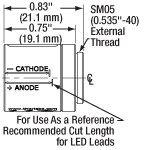
Click for Details
Figure 632A LEDMT1Eの図面
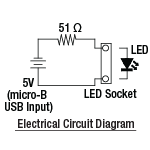
Click to Enlarge
Figure 632B LEDMT1Eの電気回路図
- T-1 3/4パッケージLED用USB電源供給マウント
- 51 Ωまたは62 Ωの電流制御抵抗内蔵
- SM05外ネジ
- LED電源モジュール用Micro-B - Type-A変換USBケーブルが付属
こちらのUSB電源駆動LEDマウントは、T-1 3/4パッケージのマウント無しLED用で電源供給とLED取付けソケットの両方が付いたコンパクトな筐体です。様々な電流要件に対応するため、51 Ωまたは62 Ωの電流制御抵抗付きのLEDマウントをご用意しております。モジュールは筐体背面のmicro-B USBポートからUSB電源、または付属のUSB-Micro-B USBケーブルにつないでPCより電源が供給されます。筐体にはSM05外ネジが付いており、ケージシステムやSM05ネジ付き部品が取り付けられます。
LEDを取り付ける際には、筐体に刻印されている長さを参考にリード線を切断してください(Figure 632Aをご覧ください)。LEDは、(+)にアノード、(-)にカソードを挿してください。LEDを取り付ける際に過度の力を加えると電極リード線が曲がる恐れがあります。
こちらの電源供給マウントは抵抗値と入力電圧が固定です。LEDに適したマウントを選ぶことでLEDへのダメージが最小限に抑えられます。一般的に抵抗値の低いマウントは順電流を増加させ、それに比例してLEDの光出力が増加します。しかし順電流がLEDの最大電流を超えると、LEDの恒久的なダメージの原因になる場合があります。LED使用時に推奨される最小抵抗値(R)は、下記の式を用いて求められます。

マウントの入力電圧(VI,Source)は5V、そして典型的な順電圧(VF,Typ) ならびに最大順電流(IF,Max)は、各LEDによります。これらの値についてはLEDの仕様をご覧ください。

| Table 307A LED Mount Compatibility | ||||
|---|---|---|---|---|
| Item # | LED Package | External Mounting Threads | Compatible Spanner Wrenches | |
| Mount | LED Retaining Ring | |||
| LEDMF | TO-18, TO-18R, and T-1 3/4a | Smooth Bore | N/A | N/A |
| S05LEDM | TO-18, TO-39, TO-46, and T-1 3/4a | SM05 (0.535"-40) | SPW603 SPW801 | SPW301 SPW801 |
| S1LEDM | SM1 (1.035"-40) | SPW909 SPW801 | ||
LEDマウントLEDMFは、付属のアダプターリング(TO-18用はØ4.7 mmアダプタ、T-1 3/4用はØ5 mmアダプタ)の1つを使ってT-1 3/4やTO-18パッケージを保持する設計となっております。また、TO-18Rパッケージは直接保持することが可能です。LEDはマウント上部にあるキャップスクリュを2 mm六角レンチで締め付けることによって固定されます。L字型のマウントにはM4キャップスクリュが使用できるザグリ穴(貫通穴)があるので LEDMFをØ12 mmまたはØ12.7 mmポストに取り付けることができます。
LEDマウントS05LEDMにはSM05ネジ加工、S1LEDMにはSM1ネジ加工が施されています。 こちらは、付属のアダプターリングを用いて当社のTO-18、TO-39、TO-46、T-1 3/4パッケージを保持する設計となっております。外ネジ加工なので様々なSM05またはSM1ネジ対応オプトメカニクス部品に適用できます。
固定リングをマウントにねじ込む、またはマウントを他の部品に結合する際には当社のスパナレンチのご使用をお勧めいたします。 調整機能付きスパナレンチSPW801は、LEDの固定リングをマウントにねじ込む際やマウントを他の部品に結合する際に使用できます。 またTable 307Aには各マウントに対応可能なスパナレンチが記載されています。

| Specifications | |
|---|---|
| Conductor | Beryllium Copper (BeCu) |
| Insulator | PTFE |
| Compatible Lead Diameters | 0.015" - 0.025" (0.38 mm - 0.64 mm) |
| Compatible Lead Lengths | ≤0.15" (3.8 mm) |
| Outer Diameter | 0.25" (6.4 mm) |
| Substrate Thickness | 0.27" (6.9 mm) |
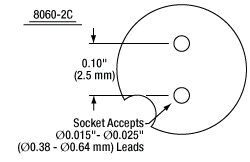
Click to Enlarge
Figure 470A ソケット8060-2C
リード線が2本ついたLEDにお使いいただけるLEDソケットをご用意しています。Ø0.38~Ø0.64 mm、長さ3.8 mm以内のリード線に適合するサイズです。ソケットの接触部はBeCu金メッキ仕上げでRoHSに準拠しています。色は製造ロットにより異なり、白、オフホワイト、黒、薄茶になります。
 Products Home
Products Home











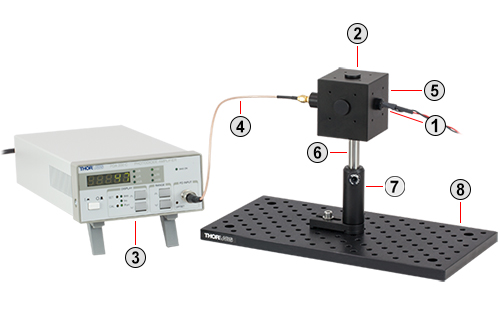
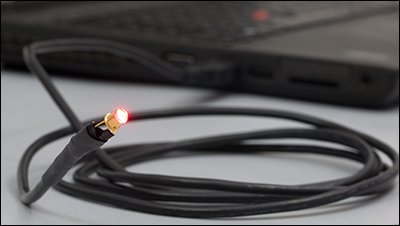

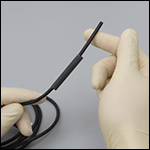

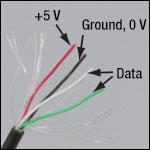
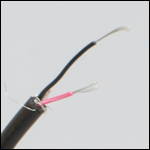
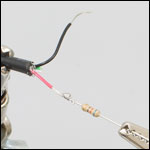

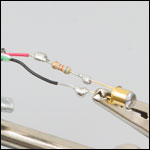
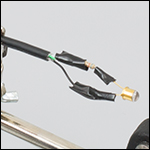
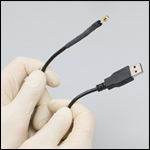
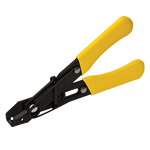

 ズーム
ズーム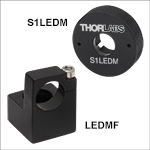
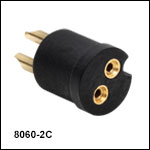
 マウント無しLED
マウント無しLED